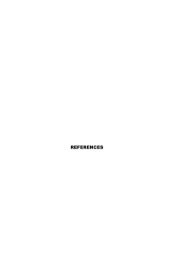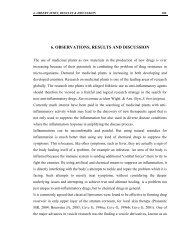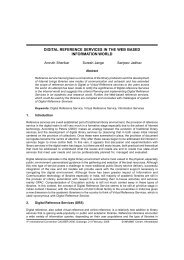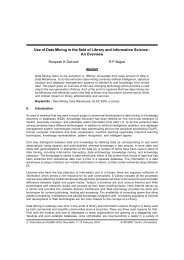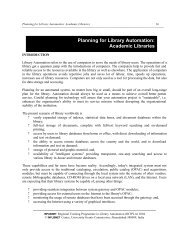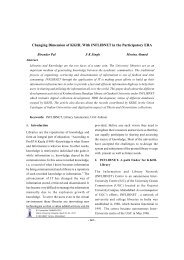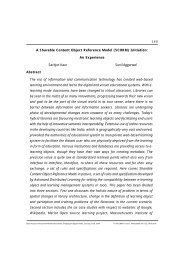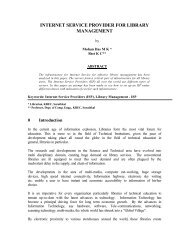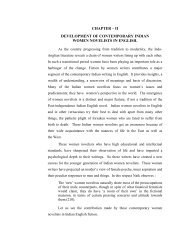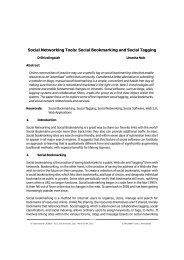Create successful ePaper yourself
Turn your PDF publications into a flip-book with our unique Google optimized e-Paper software.
Chapter 3Comparative Study of Punjabi and English3.1 Introduction to PunjabiPunjabi is an ancient language mostly used in the region of Punjab in India andPakistan. Its script Gurmukhi is based on Devanagri. The word Punjabi qualifiesanything or anyone that is related to either Punjab or the Punjabi language. Beingan official language of the Indian state of Punjab, it is also spoken in itsneighbouring areas such as Haryana and Delhi. In Canada, Punjabi is the the6th largest language with 2,71,220 people using it on daily basis. Punjabi is thesacred language of the Sikhs, in which the religious literature is written. It is theusual language of Bhangra music, which has recently gained wide popularity bothin South Asia and abroad.Punjabi language has borrowed extensively from other languages, includingHindi, Urdu, Persian and English. Like other North Indian languages, it is derivedfrom Sanskrit and is therefore Indo-European. Many sources subdivide thePunjabi language into Western Punjabi and Eastern Punjabi. Several differentscripts are used for writing the Punjabi language, depending on the region andthe dialect spoken, as well as the religion of the speaker. Sikhs and others in theIndian state of Punjab tend to use the Gurumukhi. Hindus, and those living inneighbouring states such as Haryana and Himachal Pradesh sometimes use theDevanagari script. Finally, Muslims, and in general Pakistani Punjabis, use a85
modified Arabic script called Shahmukhi. Much like English, Punjabi has movedaround the world and developed local forms by integrating local vocabulary.While most loanwords come from English, Hindi and Urdu, Punjabi emigrantsaround the world have integrated terms from languages such as Spanish, Dutch,Arabic, Persian and even a few from Turkish.3.2 Grammar of PunjabiThe grammar of the Punjabi language is the study of the word order, casemarking, verb conjugation, and other morphological and syntactic structures ofthe Punjabi language. Punjabi has a canonical word order of SOV (Subject-Object-Verb). It has postpositions rather than prepositions. Punjabi distinguishestwo genders, two numbers, and five cases of direct, oblique, vocative, ablative,and locative/instrumental.[88] The latter two cases are essentially now vestigial.The ablative occurs only in the singular and the locative/instrumental is confinedto set adverbial expressions.3.2.1 Punjabi Word Classes and its differences with EnglishThis section describes Punjabi word classes and their inflectional patterns,phrases and clauses in a Punjabi sentence. Punjabi has both inflected anduninflected words. Inflection is usually a suffix, which expresses grammaticalrelationships such as number, person, tense etc.The grammatical categories in which a word of Punjabi can be divided are:86
3.2.1.1 NounsIn Punjabi, nouns are inflected for number and case. Number can be singular orPlural and the case can be direct, oblique, locative, vocative, ablative orinstrumental.For ExampleP: ਮੁੰਡੇ ਕੁੜੀ ਨੂੰ ਚੁੱਕ ਕੇ ਲੈ ਗਏT: muṇḍē kuṛī nūṃ cukk kē lai gaēAndP: ਮੁੰਡੇ ਨੇ ਆਪਣੀ ਮਾਤਾ ਨਾਲ ਦੁਰਿਵਹਾਰ ਕੀਤਾT: muṇḍē nē āpṇī mātā nāl durvihār kītāIn the first sentence, the noun ਮੁੰਡੇ (muṇḍē) is plural in direct case and is ofmasculine gender whereas in the second sentence ਮੁੰਡੇ (muṇḍē) is singular inoblique case and of masculine gender. Nouns may be further divided intoextended and unextended declensional subtypes, with the formercharacteristically consisting of masculines ending in unaccented ‘aa’ andfeminines in ‘ee’.For Example ਮੁੰਡਾ (muṇḍā) means ‘boy’ and ਕੁੜੀ (kuṛī) means ‘girl’. Similarly ਬੱਚਾ(baccā) is a male child and ਬੱਚੀ (baccī) is a female child. Though there areexceptions, but most of the words in Punjabi can be distinguished as masculineand feminine using this rule. No such distinction for masculines and femininesexist in English Language.87
In comparison with English, as ‘s’ and ‘es’ are used as suffixes to denote plurals,in Punjabi the vowel ‘◌ੇ’(ē) or the word ‘ਆਂ’(āṃ) is used to denote plurals. ForExample Plural of ਮੁੰਡਾ (muṇḍā) is ਮੁੰਡੇ (muṇḍē) and ਕੁੜੀ (kuṛī) is ਕੁੜੀਆਂ (kuṛīāṃ).3.2.1.2 AdjectivesAdjectives may be divided into inflected and uninflected categories. InflectedAdjectives are marked, through termination, for the gender, number and case ofthe nouns they qualify. The set of inflected adjective terminations is similar butgreatly simplified in comparison to that of noun terminations. For Example ਛੋਟਾ ਬੱਚਾ(chōṭā baccā) where ਛੋਟਾ (chōṭā) is adjective for boy and ਛੋਟੀ ਬੱਚੀ (chōṭī baccī)where ਛੋਟੀ (chōṭī) is adjective for girl which is in accordance with the gender of thenoun it qualifies. Similarly for numbers, it also differs. In English, there are nosuch inflections for adjectives corresponding to the nouns they qualify. As small,fat, little, thin can be used for masculine, feminine, singular or plural.Uninflected adjectives are completely invariable, and can end in eitherconsonants or vowels. For Example ਉਦਾਸ (udās), ਉਪਯੋਗੀ (upyōgī), (ਬਦਸ਼ਕਲbadshakal).All adjectives can be used either attributively, predicatively, or substantively.Those used substantively are declined as nouns rather than adjectives.[88]88
3.2.1.3 PostpositionsThere are postpositions in Punjabi in parallel to prepositions in English. In Englishprepositions are used at the start of phrase whereas in Punjabi postpositions areused at the end of phrase. It is their use with a noun or verb that is whatnecessitates the noun or verb taking the oblique case. Such core postpositionsinclude:ਦਾ(dā), ਦੀ(dī), ਦੇ(dē) – genitive marker; variably declinable in the manner ofan adjective. X dā/dī/ etc. Y has the sense "X's Y", with dā/dī etc. agreeingwith Y.ਨੂੰ (nūṃ) – marks the indirect object (hence named "dative marker"), or, ifdefinite, the direct object.ਨੇ (nē) – ergative marker; applicable to subjects of transitive perfectiveverbs.[89]Other postpositions are adverbs, following their obliqued targets either directly orwith the inflected genitive linker ਦੇ (dē). For Example ਪੁਿਲਸ ਿਹਰਾਸਤ ਿਵੱਚ (pulis hirāsatvicc) - "in police custody", ਮੇਰੇ ਲਈ (mērē laī) - "for me". Many such adverbs (theones locative in nature) also possess corresponding ablative forms. For Example.ਿਵੱਚ (vicc) - "in",ਿਵੱਚ (viccōṃ) - "from in, among". Similarly there are otherpostpositions like ‘ਉਤੇ’(uttē)- ‘ਤ’(tōṃ) etc.89
3.2.1.4 PronounsPronouns can be classified as Personal, Reflexive, Demonstrative, Indefinite,Relative and Interrogative Pronouns. All the pronouns are inflected for gender,number and case. In addition to above, Personal pronouns are also inflected forperson information. Punjabi has personal pronouns such as ‘ਮ’(maiṃ),‘ਮੇਰਾ’(mērā), ‘ਤੁਸ’(tusīṃ) etc. for the first and second persons, while for the thirdperson demonstrative pronouns such as ‘ਉਹ’ (uh), ‘ਇਹ’(ih) are used which can befurther categorized deictically as remote and near respectively. In contrast toEnglish, personal pronouns in Punjabi have a distinction in ਤੂੰ (tūṃ) and ਤੁਸ(tusīṃ). This latter "polite" form is also grammatically plural. The reflexivepronoun ਆਪ (āp), with a genitive of ਆਪਣਾ (āpaṇā) is mostly used. In contrast toPunjabi, English translation of reflexive pronoun is different for demonstrative andpersonal pronouns. For ExampleP: ਮ ਆਪਣਾ ਕੰਮ ਕਰ ਿਰਹਾ ਸੀT: maiṃ āpaṇā kamm kar rihā sīE: I was doing my workP: ਉਹ ਆਪਣਾ ਕੰਮ ਕਰ ਿਰਹਾ ਸੀT: uh āpaṇā kamm kar rihā sīE: He was doing his workIn both the sentences ‘ਆਪਣਾ’(āpaṇā) is used in Punjabi whereas in English, ‘my’is used for ‘I’ and ‘his’ for ‘he’.90
‘ਕੋਈ’(kōī ), ‘ਕੁਝ’(kujh), ‘ਹੋਰ’(hōr) etc. are some of the indefinite pronouns used inPunjabi and ‘ਸੋ’(sō), ‘ਜੋ’(jō), ‘ਿ◌ਜਹੜਾ(ijhaṛā) etc. are the relative pronouns. ‘ਕੌਣ’(kauṇ), ‘ਿਕਹੜਾ’ (kihṛā), ‘ਿਕਹੜੀ’(ikhaṛī) are the interrogative pronouns used to askquestions. ‘ਕੌਣ’ (kauṇ) is used for animate nouns whereas other two are used forinanimate nouns. Similarly other interrogative pronouns are ‘ਿਕਸਦਾ’(iksadā ),‘ਿਕਵ’(ikvēṃ) etc.[88]3.2.1.5 VerbsThe Punjabi verbal system is largely structured around a combination of aspectand tense/mood. Like the nominal system, the Punjabi verb involves successivelayers of inflectional elements to the right of the lexical base. Punjabi has twoaspects in the perfective and the habitual, and possibly a third in the continuous,with each having over morphological correlates. There are participle forms,inflecting for gender and number by way of vowel termination, like ‘ਗਈ’ (gaī),‘ਗਏ’(gaē), ‘ਿਗਆ’ (igaā) whereas English equivalent of all of them is ‘gone’.The main component of Punjabi verb phrase is the root verb. Most of the verbsused in Punjabi language are one word, but there can be two word verbs such asdouble verbs and conjunct verbs. For Example, ਟੁਰ-ਟੁਰ ਕੇ (ṭur-ṭur kē), ਖਾਧਾ-ਪੀਤਾ(khādhā-pītā) are double verbs. In English almost all the nouns can occur asverbs. But in Punjabi, verbalization of nominal is effected by combining twolexical items - noun and a simple verb, these verbs are placed in the category ofconjunct verbs. These are certain verbs such as ਕਰਨਾ (karnā), ਕੀਤਾ (kītā), ਿਦੱਤਾ91
(dittā) etc which have their translated word in English depending upon the nounwhich precedes this word. [90]For ExampleP: ਮੇਰੀ ਅਰਜ਼ੀ ਮੰਜ਼ੂਰ ਕੀਤੀ ਗਈT: mērī arzī maṃzūr kītī gaīE: My application was acceptedP: ਜੱਜ ਨੇ ਦੋਸ਼ੀ ਨੂੰ ਮਾਫ਼ ਕੀਤਾT: jajj nē dōshī nūṃ māf kītāE: Judge forgive culpritP: ਉਹ ਨੇ ਮੇਰੇ ਉਤੇ ਹਮਲਾ ਕੀਤਾT: uh nē mērē uttē hamlā kītāE: He attacked meThe preceding verb in conjunct verb can be adjective also. For Example. ਖੁਸ਼ ਕਰਨਾ(khush karnā)3.2.1.6 Auxiliary verbsAuxiliary verbs are for two tenses – present and past. For Example. ‘ਹੈ’(hai) forpresent tense and ‘ਸੀ’(see) for past tense. It is also inflected for number andperson. For Example. ‘ਹਾਂ’(hāṃ), ‘ਹਨ’(hana) etc. These forms can equally be usedfor both the genders.92
3.2.1.7 AdverbsThe adverbs can be inflected or uninflected. Inflected adverbs inflect for gender,number, and case. For Example ਤੇਜ਼(tēz), ਿਪਛੇ, ਅੱਗੇ(aggē) etc.3.2.1.8 CardinalsCardinals and Ordinals are used as modifiers of a noun in a sentence. Cardinalscan equally be used for both genders and show inflection for case. For Example.ਦੋ(dō), ਚਾਰ(cār) etc.3.2.1.9 OrdinalsThe Ordinals inflect for gender and case. Generally, all the Ordinals are used insingular number. For Example ਸਤਾਰਵ(satārvīṃ), ਦਸਵ(dasvīṃ) etc.3.2.1.10 ConjunctionsA conjunction either combine two clauses in a sentence or two words in a clause.These words are uninflected and are categorized based on the type – co-ordinateand subordinate. Co-ordinate conjunctions, like ‘ਅਤੇ’(atē) - ‘and’ in English, jointwo independent clauses in a compound sentence. These can also act asconnectives for various phrases and words of word classes, like noun, pronoun,verb, adjective, and adverb. Subordinate conjunctions, like ਇਸ ਲਈ (is laī) –‘because’ in English, join an independent and a dependent clause in a complexsentence.93
3.2.1.<strong>11</strong> ParticlesAll the words of this word class are uninflected. These have been classifiedbased on their type like honorific ਜੀ(jī), negative ਨਹ(nahīṃ), ਨਾ(nā), and emphaticਈ(ī), ਹੀ(hī), ਤਾਂ(tāṃ), ਵੀ(vī). The particles like ਜੀ(jī) and ਹੀ(hī) have no equivalentsin English and are simply discarded while translated to English.3.2.2 Phrases in PunjabiA phrase is a group of two or more words grammatically linked with each other.Main difference between a phrase and a clause is that a phrase cannotsimultaneously have both the subject and predicate or verb simultaneously.Punjabi phrases can be broadly classified into two types, Nominal Phrases andVerb Phrases. Nominal phrases are built using the words of various word classeslike noun, pronoun, adjective etc. It usually functions as subject or object in asentence. Verb Phrases are built using primarily the words of main verb andauxiliary verb word classes. It functions as verb in those sentences. [88, 89]3.2.2.1 Nominal PhrasesIn this section, all the phrases are built around words of various word classes likenoun, pronoun, adjective, cardinal, ordinal, and postposition. A nominal phraseusually consists of a headword that can be a noun or a pronoun, and a number ofmodifiers. A modifier is a word that gives a specific meaning to a particular word.In the phrase – ‘ਮੋਟਾ94
ਮੁੰਡਾ (mōṭā muṇḍā), the word ‘ਮੋਟਾ (mōṭā) is acting as a modifier of the word ‘‘ਮੋਟਾ(mōṭā). The modifiers can be:Adjective: Any number of adjectives can be used. These can be iteratedfor emphasis or can form phrases with an adjective having various othermodifiers. For Example ਬਹੁਤ ਸੋਹਣੀ ਕੁੜੀ(bahut sōhṇī kuṛī),ਵੱਡੀ ਨੂੰਹ(vaḍḍī nūṃh)Numeral: Numeral phrases consisting of cardinals, ordinals, adjectives(acting as modifiers for cardinals), and particles (like ਕੁ(ku)) act asmodifiers. For Example ਪਿਹਲੀ ਜਮਾਤ(pahilī jamāt),ਚਾਰ ਹਜ਼ਾਰ ਬੱਚੇ(cār hazārbaccē), ਦੋ ਕੁ ਿਦਨ(dō ku din)Pronoun: Except first and second person personal pronouns, all thepronouns can act as modifiers for a noun, including genitive case forms offirst and second person personal pronouns. For Example ਮੇਰਾ ਮੁੰਡਾ(mērāmuṇḍā),ਉਹ ਕੁੜੀ(uh kuṛī)Verb phrase: Some verbal phrases also act as modifiers for nouns. ForExampleP: ਦੌੜਦਾ ਹੋਇਆ ਬੱਚਾ ਿਡੱਗ ਿਪਆT: dauṛdā hōiā baccā ḍigg piāNoun phrases followed by ਦਾ (da) postposition in its various inflectionalforms, can act as an adjective phrase modifying another noun. ForExample ਲਕੜੀ ਦੀ ਕੁਰਸੀ(lkaṛī dī kurasī), ਵਕੀਲ ਦਾ ਘਰ(vakīl dā ghar)Honorific particles like ਜੀ(jī), ਸਾਿਹਬ(sāhib), can also follow a noun to modify it. Forthe purpose of concordance, a noun followed by an honorific particle will be95
considered as plural irrespective of its number, if that noun is acting as a subjectof a sentence or a clause. For example,P: ਮੇਰੇ ਿਪਤਾ ਜੀ ਮੇਰੇ ਨਾਮ ਤੇ ਵਸੀਅਤ ਕਰ ਗਏ ਹਨT: mērē pitā jī mērē nām tē vasīat kar gaē hanP: ਮੈਨੂੰ ਵਕੀਲ ਸਾਿਹਬ ਦਾ ਕੰਮ ਮਨਜ਼ੂਰ ਹੋਵੇਗਾT: mainūṃ vakīl sāhib dā kamm manzūr hōvēgāBased on the above structure of noun phrase, the nominal phrases canfurther be categorized into at least three types, which are:Noun phraseNoun phrase having headword in direct case or in oblique case followedby postpositions – ਨੇ (nē) or ਨੂੰ(nūṃ), are used as main sentence elements.If the headword is a pronoun, then it may not take ਨੇ (nē) or ਨੂੰ (nūṃ) ratherit will be in instrumental case (for ਨੇ (nē)) or dative case (for ਨੂੰ (nūṃ)) form,instead.Adjective phraseNoun phrase in oblique case followed by ਦਾ(dā) postposition, pronoun ingenitive case, or one or more adjectives, will act as adjective phrase insentences. For ExampleP: ਕੁੜੀ ਬਹੁਤ ਸੋਹਣੀ ਹੈT: kuṛī bahut sōhṇī haiP:ਇਹ ਿਕਤਾਬ ਮੇਰੀ ਹੈT: ih kitāb mērī hai96
In the above sentences ਬਹੁਤ ਸੋਹਣੀ(bahut sōhṇī) and ਮੇਰੀ(mērī) are theadjective phrases.Postpositional phraseNoun phrase in ablative or locative case or in oblique case followed by anypostposition, or an adverb are used as adjuncts in sentences. ForExampleP: ਉਹ ਆਪਣੇ ਿਰਸ਼ਤਦਾਰਾਂ ਕੋਲ ਜਾ ਿਰਹਾ ਸੀT: uh āpaṇē rishtadārāṃ kōl jā rihā sīP: ਬੋਰੀਆਂ ਿਵੱਚ ਮੋਟਾ ਦਾਣੇਦਾਰ ਲੂਣ ਸੀT: bōrīāṃ vicc mōṭā dāṇēdār lūṇ sīIn the above sentences ਆਪਣੇ ਿਰਸ਼ਤਦਾਰਾਂ ਕੋਲ(āpaṇē rishtadārāṃ kōl) andਬੋਰੀਆਂ ਿਵੱਚ (bōrīāṃ vicc) are the postpositional phrases ending in thepostpositions ਕੋਲ(kōl) and ਿਵੱਚ(vicc).3.2.2.2 Verb PhrasesA verb phrase besides having main verb forms may have the words of someother word classes like, auxiliary verb, particle (emphatic and negative particles),and some operators such as primary, modal, progressive or passive operatorsemphasizing the main verbs. If all these elements are present, they follow aparticular order. Emphatic and negative particles will follow the main verb formthat are emphasized or negated respectively. In all cases, negative particles will97
follow emphatic particles, if present, and auxiliary verb, in turn, will follownegative particles.There are four sub-categories of main verb word class to make the structure offinite verb phrase clearer. Finite verb phrase is that which consists of only finiteform of verbs. These categories are primary, passive, progressive, and modaloperator. Members of these operator categories follow the main verb in particularphrase in a specified order. When these sub-categories are present in the verbphrase then the grammatical information is represented through these subcategories.The primary operator category has 34 members, these are – ਆ (ā), ਸਕ (sak), ਹੋ(hō), ਕਰ (kar) etc. These operators follow certain forms of words of the main verbword class. A verb phrase will be termed as passive if it has a passive operator.ਜਾ (jā) and ਹੋ (hō) are its two members . These follow main verb or primaryoperator (if represented) even in their inflectional form.[90]P: ਮ ਇਹ ਕੰਮ ਕਰ ਸਕਦਾ ਹਾਂT: maiṃ ih kamm kar sakdā hāṃIn this ‘ਸਕਦਾ’(sakdā) is the primary operator.Similary in the following sentence ‘ਜਾ’(jā)’(jā) is the passive operator and ‘ਿਰਹਾ’ (rihā) is the progressive operator whichshows the continuous nature of verb phrase.P: ਮੋਹਨ ਇਥੇ ਬੈਠ ਜਾT: mōhan ithē baiṭh jā98
P: ਮ ਸਕੂਟਰ ਤੇ ਜਾ ਿਰਹਾ ਸੀT: maiṃ sakūṭar tē jā rihā sīBased on the position, Verb phrases can also be classified into two types, MainVerb Phrase and Subordinate Verb Phrase.Main Verb PhraseThese verb phrases constitute independent clauses and occupy the positionknown as predicate in a sentence.Subordinate Verb PhraseThese verb phrases differ from main verb phrase in the sense that these usuallyprecede main verb phrase in a sentence structure, and thus constitute dependentclauses.For Example.P: ਮ ਇਹ ਕੰਮ ਕਰ ਕੇ ਚਲਾ ਜਾਵਾਂਗਾT: maiṃ ih kamm kar kē calā jāvāṅgāIn this sentence ‘ਕਰ ਕੇ (kar kē) is the subordinate phrase whereas ‘ਚਲਾ ਜਾਵਾਂਗਾ (calājāvāṅgā) is the main verb phrase.3.2.3 Clauses in PunjabiUnlike Phrases which cannot simultaneously have both the subject and predicateor verb, a clause can contain both a subject and a predicate. [88, 89]Some of the clause structures applicable to simple sentences are :99
VPA clause can be formed of just one verb phrase (VP), which will be themain verb phrase, e.g.ਸ ਜਾ (sauṃ jā ) – sleep, ਉਠ ਚਲ (uṭṭh cal) – lets goNP (NP|AP|PP)* VPIn this structure, the first structure is a noun phrase and referred as subject nounphrase whereas the inner phrases which can be a noun phrase, an adjectivephrase or a postpositional phrase and can occur in any number and followed by averb phrase. The symbol ‘|’ is used for ‘either or’, i.e. in a sentence either theelement on the left side of ‘|’ will be present or the one on the right side. ‘*’ is usedto indicate that the enclosed elements can occur zero or more number of times.In the examples, the parentheses mark the phrase boundaries. NP VPP: ਮ ਅਪੀਲ ਕਰਦਾ ਹਾਂT: maiṃ apīl karadā hāṃ NP PP VPP: ਲਾਸ਼ ਪੋਸਟਮਾਰਟਮ ਲਈ ਭੇਜ ਿਦੱਤੀT: lāsh pōsṭamārṭam laī bhēj dittī NP AP VPP: ਉਸਦਾ ਪੁੱਤਰ ਬਹੁਤ ਚੰਗਾ ਹੈT: Usdā puttar bahut caṅgā hai100
3.2.4 SentenceThe sentences are usually based on the clauses. The simplest form of asentence has only one independent clause. Punjabi sentences follow a SOV(Subject Object Verb) order unlike English that follows SVO order. In Punjabisentences, the subject occurs first followed by the object and then the verb. Thenominal phrases act as subject and object in a clause or sentence, and the verbphrases constitute the verb part of that clause or sentence.Based on the structure, the sentences can be classified into three categories:3.2.4.1 Simple SentenceA sentence that has only one clause in its structure and that clause is anindependent clause. For Example.P: ਕਾਰ ਲੋਕਾਂ ਉਤੇ ਜਾ ਚੜੀT: kār lōkāṃ uttē jā caṛhī3.2.4.2 Compound SentenceA sentence that is formed of two or more independent clauses joined bycoordinate conjunctions ਅਤੇ (atē ) and ਜਾਂ (jāṃ) etc. For ExampleP: ਬੱਸ ਿਲ◌ੁਧਆਣੇ ਵਲ ਮੋਗੇ ਜਾ ਰਹੀ ਸੀ ਅਤੇ ਰਸਤੇ ਿਵੱਚ ਐਕਸੀਡਟ ਹੋ ਿਗਆT: bass ludhāṇē valōṃ mōgē jā rahī sī atē rastē vicc aiksīḍaiṇṭ hō giā101
3.2.4.3 Contracted SentenceContracted sentence is one special form of compound sentence, in which thecommon part of its constituents is dropped. For exampleP: ਜਾਂ ਮ ਜਾਵਾਂਗਾ ਜਾਂ ਤੂਂ ਜਾਵਗਾT: jāṃ maiṃ jāvāṅgā jāṃ tūṃ jāvēṅgā3.2.4.4 Complex SentenceA sentence that has one independent and one or more dependent clauses joinedby subordinate conjunctions, like ਜੇ (jē) etc. For ExampleP: ਜੇ ਮ ਨਹ ਆਈ ਤਾਂ ਇਹ ਿਚੱਠੀ ਭੇਜ ਿਦੱਤੀ ਜਾਵੇT: jē maiṃ nahīṃ āī tāṃ ih ciṭṭhī bhēj dittī jāvē3.3 Differences between English and Punjabi3.3.1 Structural Difference1. The main structural difference between English and Punjabi is the difference intheir word orders. English is a Subject-Verb-Object language and Punjabi is aSubject-Object-Verb language. For ExamplePunjabi SentenceP: ਡਾਕਟਰ ਆਪਣਾ ਿਨੱਜੀ ਕਲੀਿਨਕ ਚਲਾ ਿਰਹਾ ਹੈT: ḍākṭar āpaṇā nijjī kalīnik calā rihā hai_____ _______________ __________S O V102
English sentenceE: Doctor is running his private clinic_____ ________ ______________S V O2. English and Punjabi differ on the basis of word order. English is a fixed wordorder language whereas like most other Indian languages, Punjabi is free wordorder language. i.e. In English relation between words in a sentence can befound from the position of the words in the sentence. The position immediatelypreceding a verb, marks the subject and the one immediately following the verb,marks an object. On the other hand, Punjabi is relatively free word orderlanguage. The following two Punjabi sentences with change in the order of wordshave the same meaning, but same change in English shows a drastic change inthe meaning. [91]P: ਮੋਹਨ ਘੋੜਾ ਲੈ ਿਗਆT: mōhan ghōṛā lai giāE:Mohan took horseP: ਘੋੜਾ ਮੋਹਨ ਲੈ ਿਗਆT: ghōṛā mōhan lai giāE:Horse took mohanIn the above sentences, In case of English Language, the first phrase isconsidered as subject and when reversed, it has opposite meaning whereas inPunjabi, the second sentence is interpreted as ਘੋੜੇ ਨੂੰ ਮੋਹਨ ਲੈ ਿਗਆ (ghōṛē nūṃ103
mōhan lai giā) which has same meaning as the first sentence. This is the casewhere the information is recovered from other sources, such as world knowledge.Unlike Punjabi, English codes the information indicating grammatical relations insubject and object positions. Both the subject as well as object positions carrycrucial information.3.3.2 Punjabi has Post Positions, English has Pre-Positions.For Example ਖੇਤਾਂ ਿਵੱਚ (khētāṃ vicc) in fieldsLeaving apart the subject position, the remaining part of the sentence of Englishis exactly the mirror image of the corresponding Punjabi sentence structure.For ExampleLook at the following Punjabi Sentence and its English translation.P: ਬੱਸ ਖੇਤਾਂ ਿਵੱਚ ਵੜ ਗਈT: bass khētāṃ vicc vaṛh gaīE: Bus entered in fields3.3.3 Order of Words in Verb PhrasesIn Punjabi, the order between main verb and the auxiliary is in reverse order as inEnglish. In Punjabi the verb groups are formed by the main root, auxiliary andother operators are used to put emphasis on the verb. These operators orauxiliaries are used after the main verb. For Example. ਜਾ ਰਹੀ ਹੈ (jā rahī hai), ਵੜ ਗਈਸੀ (vaṛ gaī sī). However, in English the order is auxiliary verbs followed by themain verb. For Example ‘is going’, ‘had entered’.104
3.3.4 Extra OverheadsSince English codes information in Subject Position, the Subject position can't beempty. This forces English to bear an extra overload of dummy ‘it’ and existential‘there’ to fill the Subject Positions where in a Punjabi sentence, subject positionmay be empty.3.3.4.1 Dummy/Expletive ‘It’Consider the following sentencesP: ਮਹ ਵਸ ਿਰਹਾ ਹੈT: mīṃh vas rihā haiE: It is rainingP: ਬਾਹਰ ਬਹੁਤ ਗਰਮੀ ਹੈT: bāhar bahut garmī haiE: It is very hot outside.In above Punjabi sentences, there is no need of subject whereas in Englishtranslations dummy ‘it’ is needed to convey the meaning. As the name impliesthis ‘it’ does not carry any information, and is just a place holder or a stand-by.3.3.4.2 Expletive ‘There’Similarly ‘There’ is used in EnglishConsider the following sentencesP: ਦੰਗੇ ਹੋ ਸਕਦੇ ਸਨ105
T: daṅgē hō sakadē sanE: There could have occurred riotsIn English sentences, the subject position is occupied by the word ‘there’whereas there is no need of subject in its Punjabi translations. English requiresthis existential ‘there’ as the words or phrases that are to be focussed arenormally moved into a focus position at the front of a clause in order to highlightit. When a verb is to be focussed, it is not possible to bring it to the front, sincethen either the subject position will be empty or it will be an interrogativesentence. Hence in such cases, the subject position is filled with an expletive‘there’.3.3.5 Difference in Interrogative sentences:An extra word is needed in Punjabi while converting declarative sentence tointerrogative sentence whereas no extra word is needed for the same conversionin English, only the position of words are interchanged. For ExampleDeclarative sentence in Punjabi – ਤੁਸ ਇਹ ਕੰਮ ਕੀਤਾ ਹੈ (tusīṃ ih kamm kītā hai)Interrogative sentence in Punjabi – ਕੀ ਤੁਸ ਇਹ ਕੰਮ ਕੀਤਾ ਹੈ?( kī tusīṃ ih kamm kītāhai?)Declarative sentence in English- You have done this workInterrogative sentence in English – Have you done this work?In the above Punjabi sentence, the word ਕੀ (kī) is added to make it interrogativewhereas only the position of words is interchanged in English.106
If a verb form does not involve an auxiliary verb in English, then a dummy 'do' isinserted, as shown below.Declarative sentence in English- He goes to school.Interrogative sentence in English- Does he go to school?Here 'goes' is split as 'does + go' by introducing an auxiliary do, and the auxiliary"does" then inverts with the subject to give an interrogative sentence.3.4 ConclusionIn this <strong>chapter</strong> we have discussed Punjabi language and its comparison withEnglish in their structural divergences and the grammar. This study is primarilyaimed to find out the differences between Punjabi and English from the point ofview of translation. It has been observed that both the languages have differentgrammatical structures and the direct approach of translation is not feasible forthese languages. The Indirect, Interlingua or the Statistical Approach is suitablefor translation between these languages.107



